Galaxy Surveys
Galaxy surveys is a powerful way of exploring the large scale structure of the universe, as well as a way of testing the theory of gravity.
- CfA Redshift Survey
- 2dF Galaxy Redshift Survey
- 6dF Galaxy Survey
- 2 MASS Redshift Survey
- VLA FIRST Survey
- EDisCS
- LCRS
- ESP
- CNOC
- Sloan Digital Sky Survey
- GAMA
- DEEP2 Redshift Survey, high redshift
- VIMOS-VLT Deep Survey, high redshift
- UKIDSS
- Pan-STARRS
- PRIMUS
- Spitzer
- BOSS
- DES
- LSST
- References:
CfA Redshift Survey
CfA Redshift Survey, the Center for Astrophysics Redshift Survey, is the first redshift survey.
- Objectives:
Measure radial velocities for all galaxies brighter than 14.5 and high galactic latitude in the merged catalogs of Zwicky and Nilson (UGC). {Completed}
- Parameters:
- Facilities:
- Frequency/Channel:
- Objects: Galaxies {about 18,000 measured}
- Distance: Within redshift 15,000 km/s
- Area: Northern sky
- Resolution:
- Results
Distribution of the galaxies in the northern celestial hemisphere with an apparent blue magnitude of 15.5 inside redshift 15,000 km/s,
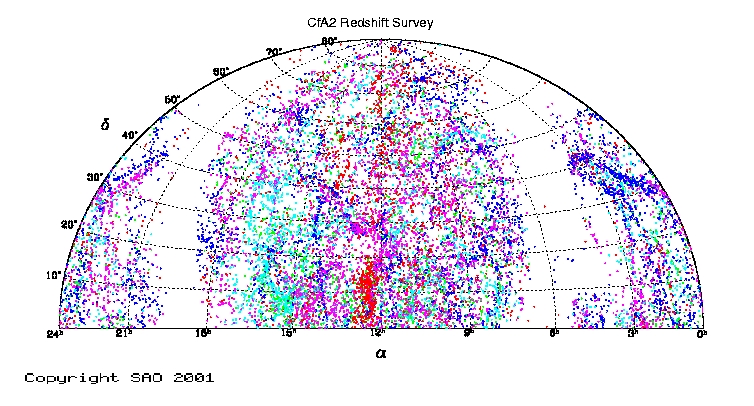
In this map, Red V < 3000 km/s; Blue 3000 < V < 6000 km/s; Magenta 6000 < V < 9000 km/s; Cyan 9000 < V < 12000 km/s; Green 12000 < V km/s.
- Links:
- CfA Redshift Survey: http://www.cfa.harvard.edu/~dfabricant/huchra/zcat
- CfA: http://www.cfa.harvard.edu
2dF Galaxy Redshift Survey
2dFGRS, 2dF Galaxy Redshift Survey, is a major spectroscopic survey (integrated with the 2dF QSO survey).
-
Objectives: {Completed}
-
Parameters:
- Facilities: 2dF facility built by the Anglo-Australian Observatory.
- Frequency/Channel:
- Objects: 245591, mainly galaxies, brighter than a nominal extinction-corrected magnitude limit of $b_J = 19.45$. Reliable (quality>=3) redshifts were obtained for 221414 galaxies.
- Distance:
- Area, 1500 square degrees. A figure from official site is shown below.
2dFGRS Survey Map 
- Resolution:
Results
Galaxy distribution results from completed survey:
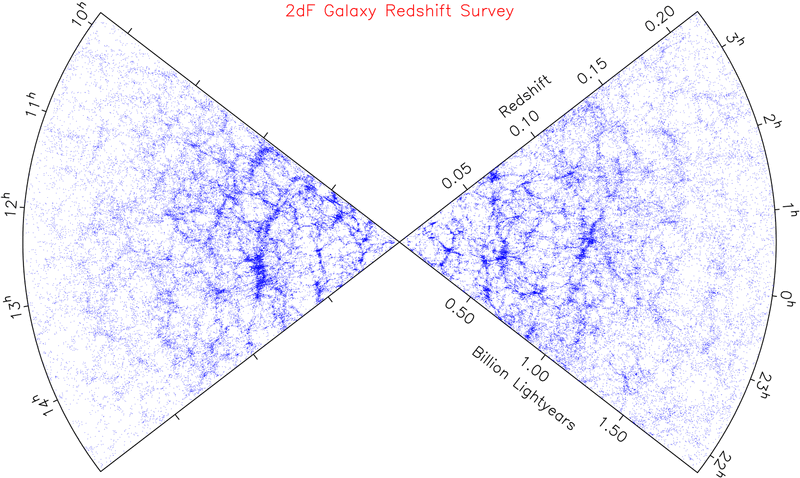
A rendered result of 2dF Galaxy Survey data

Links:
- Wikipedia: http://en.wikipedia.org/wiki/2dF_Galaxy_Redshift_Survey
- Official site: http://magnum.anu.edu.au/~TDFgg
2dF QSO Redshift Survey, 2QZ, is already integrated into 2dFGRS.
-
Objectives: {Completed}
-
Parameters:
- Facilities:
- Frequency/Channel:
- Objects: Magnitude limits are $18.25<b_J<20.85$. Color selection is $u-b_J$ vs. $b_J-r$ plane.
2QZ 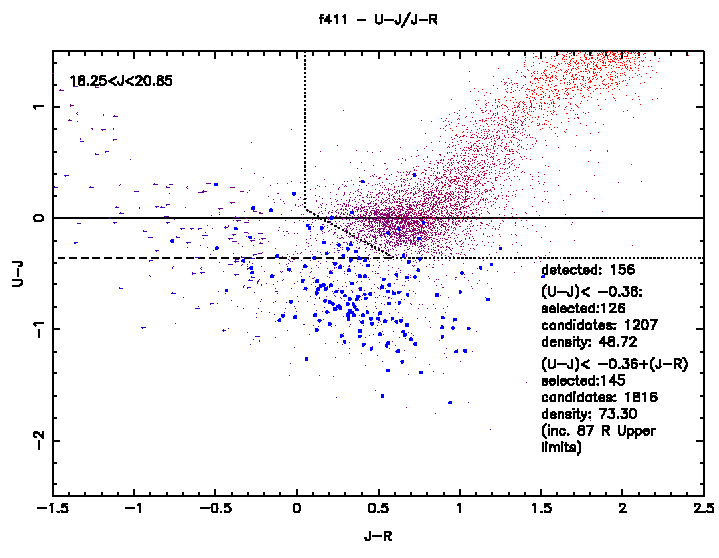
- Distance:
- Area:
2QZ 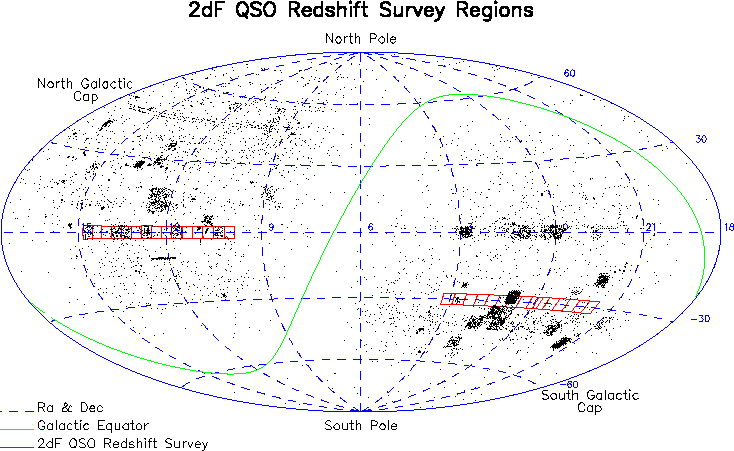
- Resolution:
6dF Galaxy Survey
-
Objectives: {Completed}
- Parameters:
- Facilities: UK Schmidt telescope using the Six-degree Field(6dF) multi-object fibre spectrograph
- Frequency/Channel:
- Objects: limits $16.0<b_J<18.25$ {136,304 spectra}.
- Distance:
- Area: Nearly the entire southern sky
6dF 
- Resolution:
- Examinations: Spectra and (in peculiar velocity survey) galaxy mass and bulk motions
- Links:
2 MASS Redshift Survey
2MASS, the Two Micron All Sky Survey, “is designed to close the gap between our current technical capability and our knowledge of the near-infrared sky. In addition to providing a context for the interpretation of results obtained at infrared and other wavelengths.” It shows the large-scale structure of the Milky Way and the Local universe.
-
Objectives: {Completed}
-
Parameters:
- Facilities: Two 1.3-m telescopes at Mt. Hopkins, AZ and CTIO, Chile.
- Frequency/Channel: 3 near-infrared bands
- Objects: Limited to local universe
- Area: All sky scanning
- Distance: Limited to local universe
- Area: All sky scanning
- Resolution: pixel size 2.0”.RNR>10.
Results
Links:
2MRS, the 2MASS Redshift Survey, aims to map the distribution of galaxies and dark matter in the local universe, based on galaxy selection of 2MASS.
-
Objectives: 45000 galaxies up to K=11.75mag {Completed}
-
Parameters:
- Facilities:
- Frequency/Channel: near infra-red J,H and K-band
- Objects: Limited to local universe
- Area: All sky scanning
- Distance: Redshift out to $z=0.03$ (mean value), or equivalently to 115Mpc/370 million light-years
- Area: All sky scanning
- Resolution: pixel size 2.0”.RNR>10.
Results
All sky map of local universe in infrared
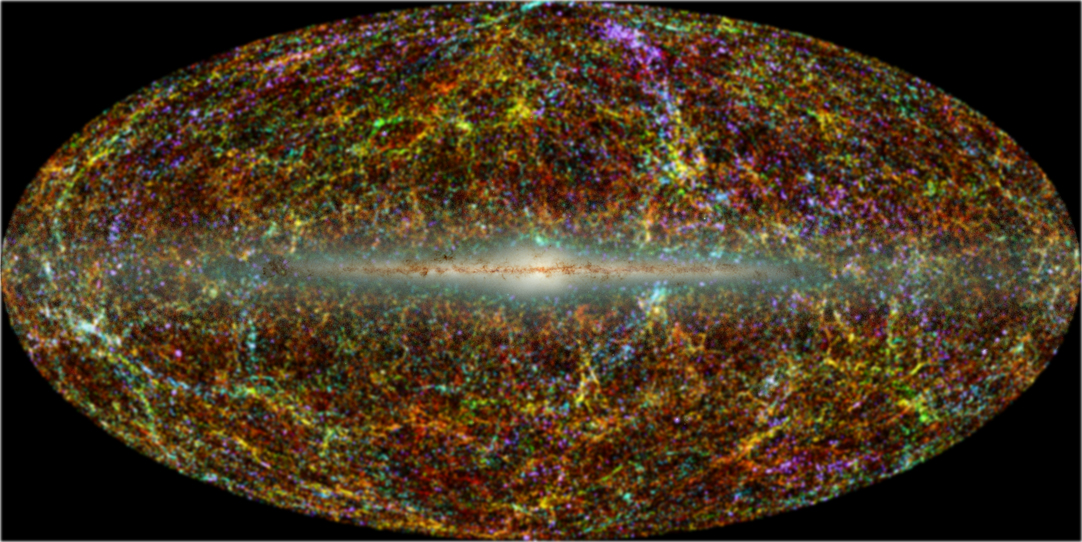
Links:
- 2MASS Redshift Survey @ CfA: http://www.cfa.harvard.edu/~dfabricant/huchra/2mass
VLA FIRST Survey
VLA FIRST Survey: Faint Images of the Radio Sky at Twenty-cm using NRAO Vary Large Array.
-
Objectives: “to produce the radio equivalent of the Palomar Observatory Sky Survey over 10,000 square degrees of the North and South Galactic Caps” {Completed}
-
Parameters:
- Facility: VLA in B-configuration
- Frequency/Channel: Two channels centered at 1365 MHz and 1435 MHz. In Spring 2011, changed due to EVLA updates
- Objects:
- Distance:
- Area: Over 10,000 square degrees of the North and South Galactic Caps.
- Resolution: Final atlas of maps have a resolution of 5’’
Results
Links:
- Faint Images of the Radio Sky at Twenty-Centimeters: http://sundog.stsci.edu
EDisCS
EDisCS: ESO Distant Clusters Survey
-
Objectives: {Completed}
-
Parameters:
- Facilities:
- Frequency/Channel:
- Objects: galaxies in rich clusters.
- Distance: z~0.5 and z>0.8
- Area:
- Resolution:
Results
Links:
LCRS
LCRS, the Las Campanas Redshift Survey
-
Objectives: “provide a large galaxy sample which permits detailed and accurate analyses of the properties of galaxies in the local universe” {Completed}
-
Parameters:
- Facilities:
- Frequency/Channel:
- Objects: Galaxies selected from a CCD-based catalog measured in a Kron-Cousins R-band
- Distance: Typical redshift is 30000 km/s
- Area: 700 square degrees in 6 strips, each 1.5 degrees * 80 degrees, three each in the North and South galactic caps.
- Resolution:
- Examinations: Clustering, luminosity, and spectral properties
Results
Two dimensional representations of the redshift distribution
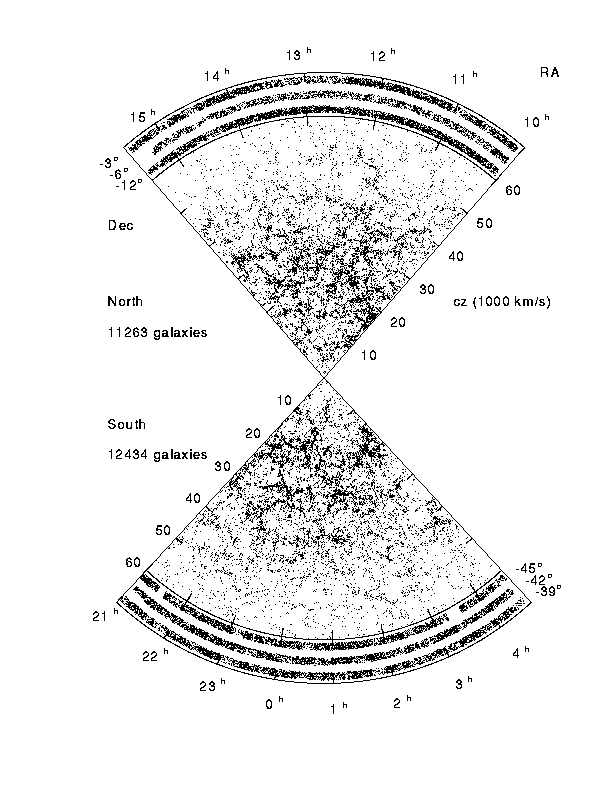
We can see voids and walls.
Links:
ESP
- Objectives: {Completed}
- Determination of the galaxy luminosity function in a volume with dimensions large enough to average over the large scale inhomogeneities.
- Study of the statistic of emission line galaxies in a large, unbiased sample of galaxies.
- Measure of the size distribution of inhomogeneities in the galaxy distribution over a large volume.
- Parameters:
- Facilities: ESO 3.6m telescope
- Frequency/Channel:
- Objects: Limiting magnitude bJ=19.4 {about 4000 objects measured, 3342 galaxy redshifts}
- Distance: Selection function peak at z=0.1
- Area: Over about 23 square degrees near the South Galactic Pole
- Resolution:
Results
Cone diagram
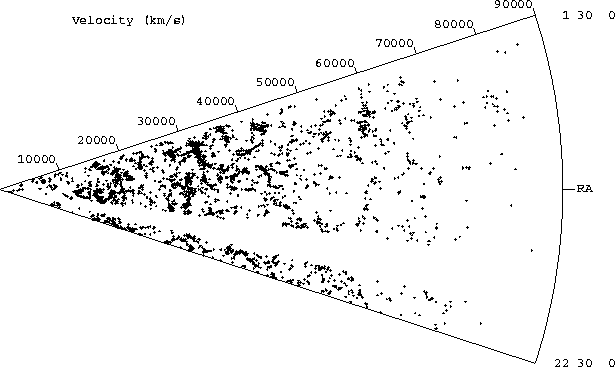
Links:
CNOC
CNOC: the Canadian Network for Observational Cosmology
The CNOC1 Cluster Survey
-
Objectives: {Completed}
-
Parameters:
- Facilities: CFHT Multi-Object-Spectrograph(MOS)
- Frequency/Channel:
- Objects: 16 rich X-ray selected galaxy clusters {about 1200 cluster redshifts and 1000 field redshifts identified}
- Distance: 0.17<z<0.55
- Area:
- Resolution:
Results
Determine Omega
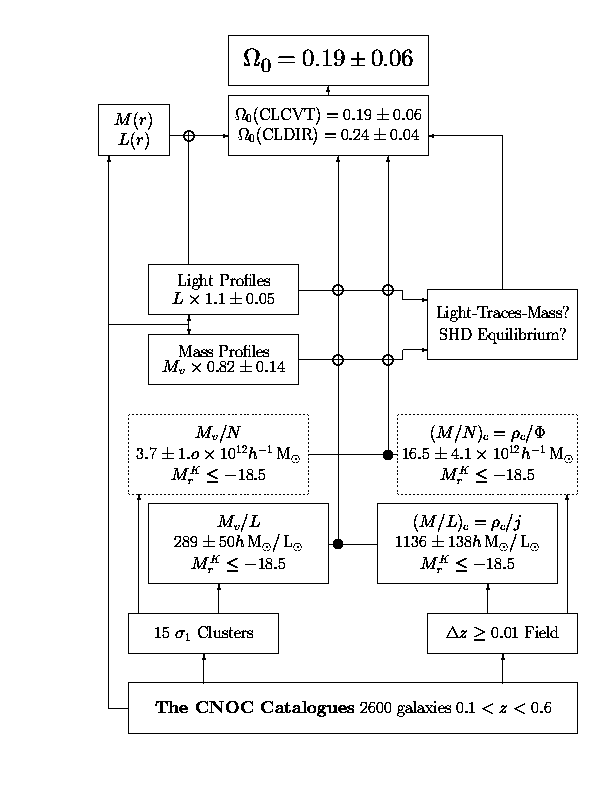
Links:
CNOC2 Field Galaxy Survey
-
Objectives: {Completed}
-
Parameters:
- Facilities: CFHT MOS
- Frequency/Channel:
- Objects: 4 widely separated patches away from very bright stars and known rich low-z galaxy clusters {about 6200 field galaxy redshifts measured}
- Distance: To z=0.7
- Area: 1.5 square degrees
- Resolution:
Results
Links:
Sloan Digital Sky Survey
SDSS: Sloan Digital Sky Survey
There are 3 programs until now. SDSS is too famous and too complicated to list here. Use the links to read it on SDSS website.
SDSS1
SDSS2
SDSS3
Links:
- SDSS: http://www.sdss.org
GAMA
GAMA: Galaxy And Mass Assembly Survey
- Objectives: “study cosmology and galaxy formation and evolution”
- To test modified theories of gravity by measuring the growth rate of structure; the CDM model by measuring the halo mass function; and galaxy formation models by measuring the star formation efficiency in groups.
- To measure the connection between star formation fuelling, stellar mass build-up and feedback processes.
- To uncover the detailed mechanisms that govern the build-up of the stellar content of galaxies.
- To directly measure the recent galaxy merger rate as a function of mass, mass ratio, local environment and galaxy type.
- Parameters:
- Facilities: AAOmega MOS on Anglo-Australian Telescope (AAT)
- Frequency/Channel:
- Objects: 340,000 galaxies down to r<19.8 mag {about how many XXXX measured}
- Distance: 0.015<z<0.04 for each GAMA fields (G09, G12, G15)
- Area: About 310 deg^2
- Resolution:
Results
Three animations to illustrate some of the results, (blue for 10^8 to 10^9 solar masses; green for 10^9 to 10^10 solar masses; orange for 10^10 to 10^11 solar masses; red for more than 10^11 solar masses)
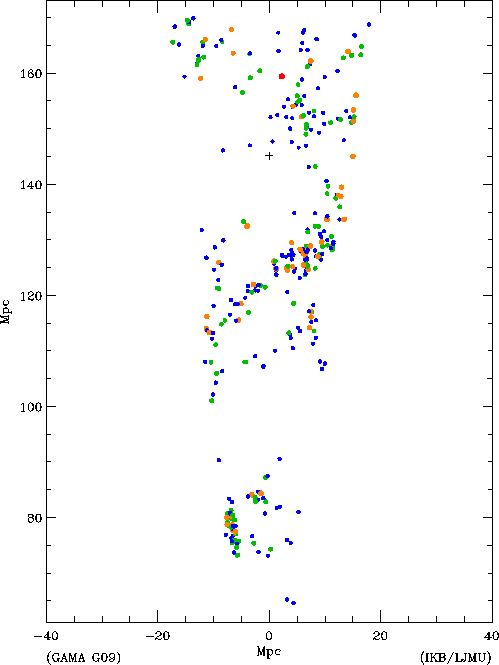
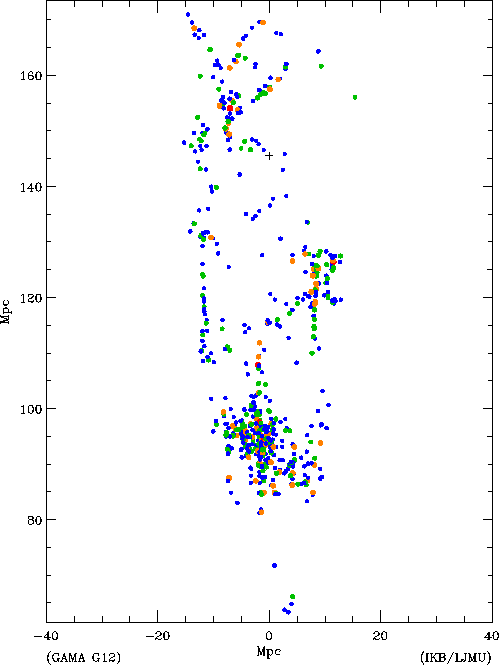
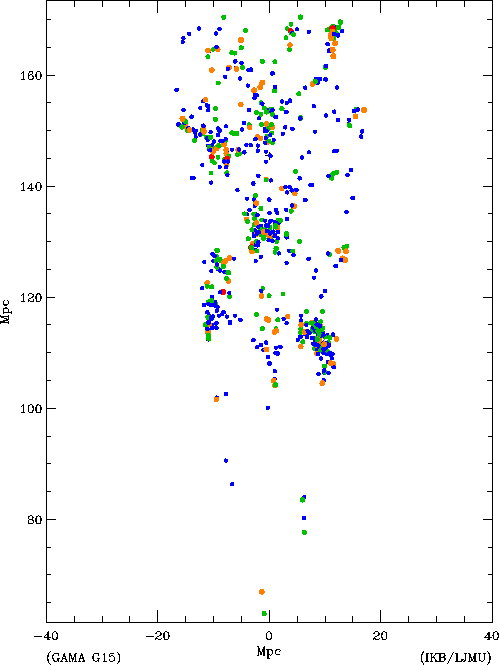
Links:
DEEP2 Redshift Survey, high redshift
VIMOS-VLT Deep Survey, high redshift
UKIDSS
UKIDSS: UKIRT Infrared Deep Sky Survey, is a successor to 2MASS and made up of five surveys and includes two deep extra-Galactic elements, one covering 35 square degrees to K=21 and the other reaching K=23 over 0.77 square degrees.
-
Objectives:
-
Parameters:
- Facilities: WFCAM on UK Infrared Telescope (UKIRT) in Hawaii.
- Frequency/Channel:
- Objects: JHK to K=18.3, principal quarry: coolest and nearest brown dwarfs, high-redshift dusty starburst galaxies, elliptical galaxies and galaxy clusters at redshifts 1<z<2, and the highest-redshift quasars at z=7
- Distance: Check objects
- Area: 7500 square degrees of Northern sky, extending over both high and low Galactic latitudes. Planned coverage is
- Orange: Large Area Survey (LAS) 4000 sq. degs K=18.4 extraGalactic
- Purple: Galactic Plane Survey (GPS) 1800 sq. degs K=19.0 Galactic
- Green: Galactic Clusters Survey (GCS) 1400 sq. degs K=18.7 Galactic
- Blue: Deep Extragalactic Survey (DXS) 35 sq. degs K=21.0 extraGalactic
- Red: Ultra Deep Survey (UDS) 0.77 sq. degs K=23.0 extraGalactic
GAMA 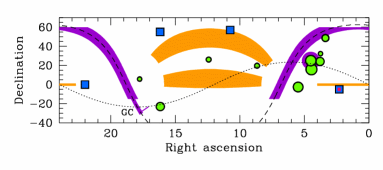
- Resolution:
Results
Links:
- UKIDSS: http://www.ukidss.org
Pan-STARRS
Pan-STARRS: the Panoramic Survey Telescope & Rapid Response System
-
Objectives: (Originally) detect potentially hazardous objects in the solar system, and other solar system astronomy and cosmology.
-
Parameters:
- Facilities:
- Frequency/Channel:
- Objects:
- Distance:
- Area:
- Resolution:
Results
Links:
- Pan-STARRS: http://pan-starrs.ifa.hawaii.edu/public
PRIMUS
PRIMUS: PRIsm MUlti-object Survey, is the largest faint galaxy spectroscopic redshift survey to date.
-
Objectives:
-
Parameters:
- Facilities:
- Frequency/Channel:
- Objects: 120,000 galaxy redshifts
- Distance: To z=1
- Area: 9 sq. deg. focusing on regions with deep Spitzer, optical, GALEX and X-ray data
- Resolution:
Results
Links:
Spitzer
BOSS
BOSS: Baryon Oscillation Spectroscopic Survey. FUTURE SURVEY
-
Objectives:
-
Parameters:
- Facilities:
- Frequency/Channel:
- Objects:
- Distance:
- Area:
- Resolution:
Results
Links
DES
-
Objectives: “designed to probe the origin of the accelerating universe and help uncover the nature of dark energy by measuring the 14-billion-year history of cosmic expansion with high precision”
-
Parameters:
- Facilities:
- Frequency/Channel:
- Objects:
- Distance:
- Area:
- Resolution:
Results
Links
LSST
LSST: the Large Synoptic Survey Telescope
-
Objectives:
-
Parameters:
- Facilities:
- Frequency/Channel:
- Objects:
- Distance:
- Area:
- Resolution:
Results
Links
- LSST: http://www.lsst.org
References:
- Probes of Large Scale Structure: http://astro.berkeley.edu/~mwhite/probes-lss.html
Template for surveys:
-
Objectives: XXXXXX {Completed}
-
Parameters:
- Facilities:
- Frequency/Channel:
- Objects: XXXX {about how many XXXX measured}
- Distance:
- Area:
- Resolution:
Results
Links: